
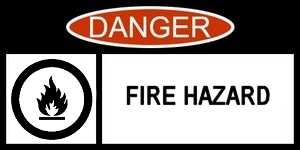
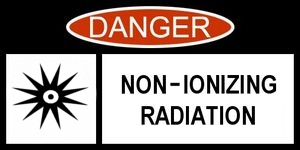
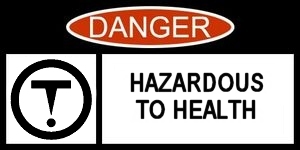
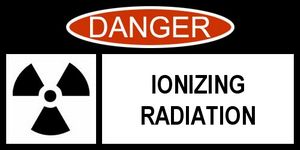
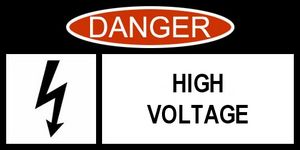
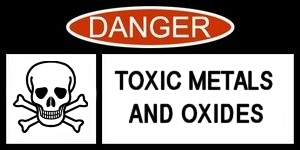
In Amateur Radio it is common to find that some people may be unaware of some of the 'common' dangers associated with communications equipment, particularly those who are entering the hobby without the benefit of any formal communications or engineering training, where safety is addressed relatively early.
This is particularly a risk to those who endeavour to build their own equipment, or may purchase used commercial or home brew items.
Whilst not comprehensive, the following page is an attempt to raise to people's attention some of the common most things to watch out for when participating in the hobby.
Whist it may seem obvious, most people forget that they are working with power supplies that operate from either 240, 220 or 110Volts.
Whilst some parts of the world have regulated that Earth Leakage Breakers (ELB's) are required as a safety feature on new switchboards, many old switchboards in many countries do not have them.
There is a common misconception by some people that having an ELB at the switchboard or on a piece of equipment will protect you from a possible electric shock. THIS IS NOT ALWAYS TRUE as ELB's will only activate under CERTAIN conditions and WILL NOT protect people in all circumstances.
For example, transformers can isolate you from the 'main's and prevent ELB's from tripping if you touch a high voltage 'secondary' supply. Power conditioning transformers which provide AC voltage stabilisation will negate the effectiveness of a switchboard ELB also.
Using an isolation transformer for testing will also do the same thing. There are more examples.
Many high voltage supplies are still dangerous even though they may be SWITCHED OFF AND UNPLUGGED from the mains. Storage capacitors in these supplies can produce lethal charges for days, months and possibly even a year after being disconnected.
There are volumes of safety instructions relating to working with high voltages for VERY GOOD REASON. If you're not sure, don't work with high voltage unless you get the appropriate training.
Whilst some parts of the world have regulated that Earth Leakage Breakers (ELB's) are required as a safety feature on new switchboards, many old switchboards in many countries do not have them.
There is a common misconception by some people that having an ELB at the switchboard or on a piece of equipment will protect you from a possible electric shock. THIS IS NOT ALWAYS TRUE as ELB's will only activate under CERTAIN conditions and WILL NOT protect people in all circumstances.
For example, transformers can isolate you from the 'main's and prevent ELB's from tripping if you touch a high voltage 'secondary' supply. Power conditioning transformers which provide AC voltage stabilisation will negate the effectiveness of a switchboard ELB also.
Using an isolation transformer for testing will also do the same thing. There are more examples.
Many high voltage supplies are still dangerous even though they may be SWITCHED OFF AND UNPLUGGED from the mains. Storage capacitors in these supplies can produce lethal charges for days, months and possibly even a year after being disconnected.
There are volumes of safety instructions relating to working with high voltages for VERY GOOD REASON. If you're not sure, don't work with high voltage unless you get the appropriate training.
Radio Communications Systems use radio frequency (RF) energy to transmit information from a transmitter to a receiver.
The radio energy varies in effect depending on the type of equipment, the frequency in use, the power emitted, the type of antenna, shielding and other associated factors.
Two things can happen when something is exposed to radiation:
* Excitation can occcur when the radiation excites the motion of the atoms or molecules, or excites an electron from an occupied orbital into an empty, higher-energy orbital.
* Ionisation can occur when the radiation carries enough energy to remove an electron from an atom or molecule completely. This type of radiation is the type found in nuclear reactors and nuclear weapons, and is considered extremely dangerous to biological systems.
The RF energy associated with radio equipment is called Non-Ionising Radiation because, regardless of the power emitted, the energy will not cause ionisation.
Although not yet shown to be entirely safe, RF energy's most noted effect is a heating effect, when produced in high enough power levels. An example is a microwave oven.
Some cordless phones operate at near microwave oven frequencies, but due to the extremely low power levels used, the heat produced is quickly carried away by blood vessels in the human body and it causes no related heat damage.
Mobile phones, cell phones, or hand held transceivers also use RF energy, but their power is not sufficient to cause damaging heating effects either. (There are studies underway to determine if there are any other damaging effects, but the findings to date are still inconclusive.)
High Power RF radiation, such as that produced by military radar, can kill or injure if strong enough or close enough, simply due the instant heating effect produced like that inside a microwave oven.
Exposure to lower levels of RF can result in RF burns, which are similar to normal burns with the difference that flesh can be burnt beneath the skin without the skin being damaged or broken. RF burns can sometimes be 'invisible' because they can be induced deep below the skin layer.
Staying physically away from strong RF fields or from any antenna or unshielded RF amplifier whilst equipment is transmitting is recommended.
The radio energy varies in effect depending on the type of equipment, the frequency in use, the power emitted, the type of antenna, shielding and other associated factors.
Two things can happen when something is exposed to radiation:
* Excitation can occcur when the radiation excites the motion of the atoms or molecules, or excites an electron from an occupied orbital into an empty, higher-energy orbital.
* Ionisation can occur when the radiation carries enough energy to remove an electron from an atom or molecule completely. This type of radiation is the type found in nuclear reactors and nuclear weapons, and is considered extremely dangerous to biological systems.
The RF energy associated with radio equipment is called Non-Ionising Radiation because, regardless of the power emitted, the energy will not cause ionisation.
Although not yet shown to be entirely safe, RF energy's most noted effect is a heating effect, when produced in high enough power levels. An example is a microwave oven.
Some cordless phones operate at near microwave oven frequencies, but due to the extremely low power levels used, the heat produced is quickly carried away by blood vessels in the human body and it causes no related heat damage.
Mobile phones, cell phones, or hand held transceivers also use RF energy, but their power is not sufficient to cause damaging heating effects either. (There are studies underway to determine if there are any other damaging effects, but the findings to date are still inconclusive.)
High Power RF radiation, such as that produced by military radar, can kill or injure if strong enough or close enough, simply due the instant heating effect produced like that inside a microwave oven.
Exposure to lower levels of RF can result in RF burns, which are similar to normal burns with the difference that flesh can be burnt beneath the skin without the skin being damaged or broken. RF burns can sometimes be 'invisible' because they can be induced deep below the skin layer.
Staying physically away from strong RF fields or from any antenna or unshielded RF amplifier whilst equipment is transmitting is recommended.
Electronics equipment also can contain carcenogenic oils along with Polychlorinated Biphenyls (PCB's), Hexavalent Chromium and other compounds which are known to be extremely dangerous to human health.
Again, most of these materials are INSIDE electronic components, so unless you know what you're doing, don't pull apart electronic components unless you know they're safe.
Also many solvents used in the electronics industry for cleaning Printed Circuit Boards or other electonic uses are toxic in confined spaces (such as shacks) without appropriate ventilation.
Always treat chemicals in the workshop as toxic and read and adhere to the warning labels.
Some of the labels may only suggest that an item should not be used in confined spaces but reading the hazmat material documentation on the chemical will reveal that it is actually carcenogenic in humans or animals, or will impair nervous system or breathing functions etc.
It's always good to be wary as the full extent of the danger may not disclosed on the label.
Again, most of these materials are INSIDE electronic components, so unless you know what you're doing, don't pull apart electronic components unless you know they're safe.
Also many solvents used in the electronics industry for cleaning Printed Circuit Boards or other electonic uses are toxic in confined spaces (such as shacks) without appropriate ventilation.
Always treat chemicals in the workshop as toxic and read and adhere to the warning labels.
Some of the labels may only suggest that an item should not be used in confined spaces but reading the hazmat material documentation on the chemical will reveal that it is actually carcenogenic in humans or animals, or will impair nervous system or breathing functions etc.
It's always good to be wary as the full extent of the danger may not disclosed on the label.
Electronics equipment will always fail and if not designed properly, can cause fires. Always ensure that fuses are in series with supplies and that where ever possible, circuit breakers are used in mains supplies.
Batteries used to back up radio systems should be outside in ventilated areas as hydrogen build up can be an explosion hazard.
Batteries can also deliver large amounts of power so if their terminals are accidently shorted by a falling metal item, a fire can easily be started.
High Voltage equipment can start fires if dust is allowed to accumulate and high power RF systems can generate plasma arcs if components break down.
Often, cheap Dry Powder type Fire Extinguishers are mounted in amateur radio shacks for use in the event of a fire, but most people are not aware that if used on electronic equipment, the dry powder becomes corrosive on contact with moisture in the air and if not removed in a relatively short period of time, damage will result. The recommended Fire Extinguisher to use is a CO2 unit, however this can be a problem in confined spaces as the oxygen will quickly be displaced.
Nuclear ionising radiation is not often found in communications systems in dangerous quantities. It will most often be found in high power radar assemblies and in high power thermionic valves or tubes, the filaments of which contain Thorium.
It will also be found in the form of X-Rays whenever high energy electrons strike a metal surface such as inside CRT Tubes or TV tubes. If the devices are operating correctly, the X-Ray emissions will be very low.
Electronics equipment sometimes contains some pretty exotic materials and not all are considered to be safe.
Generally, most consumer grade equipment will not expose you to dangerous materials unless you take the covers off a particular item and start poking around inside.
Some of the most common materials to watch out for are materials containing Beryllium Metals or the Oxides of Beryllium. Beryllium is found on some high power tubes (valves) and precision military equipment. It is a very lightweight grey metal which is extremely toxic even in microscopic amounts. It's oxide is generally like a white ceramic powder but can be mixed with pigments to produce in any colour.
Beryllium is often found in equipment as it is mixed with Copper or other alloys to produce finger stock and other contact surfaces such as relay contacts.
Beryllium Oxide (BeO) is often found in RF amplifiers. It can be found on the bottom of RF Power Transistors, the outer casings of high power semiconductors, or vacuum tubes. It is also found in most heatsink compounds used prior to the 1980's. Early transistors contained BeO in the form of a white powder inside the unit. Splitting a casing or cutting open a transistor released the deadly powder.
The heatsink compounds are generally a white, toothpaste consistency material, but were also commonly coloured pink or blue in in commercial systems. Compounds containing BeO are extremely dangerous if inhaled, ingested or allowed to contact an open wound. BeO is an extremely potent carcinogen in humans and exposure often results in cancer, sometimes many years after exposure.
I personally worked with a technician who continually ignored the safety warnings and would often eat his lunch with BeO heatsink compound material on his fingers and under his fingernails. Unfortunately he died of multiple forms of cancer only a few years after becoming complacent about the material.
Generally, most consumer grade equipment will not expose you to dangerous materials unless you take the covers off a particular item and start poking around inside.
Some of the most common materials to watch out for are materials containing Beryllium Metals or the Oxides of Beryllium. Beryllium is found on some high power tubes (valves) and precision military equipment. It is a very lightweight grey metal which is extremely toxic even in microscopic amounts. It's oxide is generally like a white ceramic powder but can be mixed with pigments to produce in any colour.
Beryllium is often found in equipment as it is mixed with Copper or other alloys to produce finger stock and other contact surfaces such as relay contacts.
Beryllium Oxide (BeO) is often found in RF amplifiers. It can be found on the bottom of RF Power Transistors, the outer casings of high power semiconductors, or vacuum tubes. It is also found in most heatsink compounds used prior to the 1980's. Early transistors contained BeO in the form of a white powder inside the unit. Splitting a casing or cutting open a transistor released the deadly powder.
The heatsink compounds are generally a white, toothpaste consistency material, but were also commonly coloured pink or blue in in commercial systems. Compounds containing BeO are extremely dangerous if inhaled, ingested or allowed to contact an open wound. BeO is an extremely potent carcinogen in humans and exposure often results in cancer, sometimes many years after exposure.
I personally worked with a technician who continually ignored the safety warnings and would often eat his lunch with BeO heatsink compound material on his fingers and under his fingernails. Unfortunately he died of multiple forms of cancer only a few years after becoming complacent about the material.


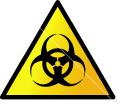
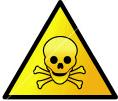

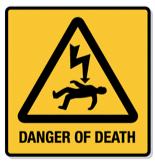
Lightning is an obvious danger to most of us but newcomers to the hobby may not be aware how easily antennas can sometimes act like lightning rods.
Even antennas that are not vertical, or antennas that are long pieces of wire strung low to the ground can be dangerous in electrical storms.
The longer or taller the antenna, the more likely that it can have a lightning induced voltage develop along it.
Lightning doesn't even have to hit the antenna. A lightning strike within hundreds of metres from the antenna could still induce enough energy into it to be a serious danger to people, or to damage equipment connected to the antenna.
Lightning arrestors can be deployed to minimise damage caused by nearby lightning strikes, but nothing will survive a direct hit. The best course of action is to disconnect any antennas BEFORE the storm arrives.
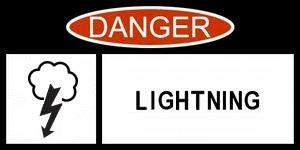
Ham Hazards
Monday, 4th July, 2010 11:02
20, 6


Search
